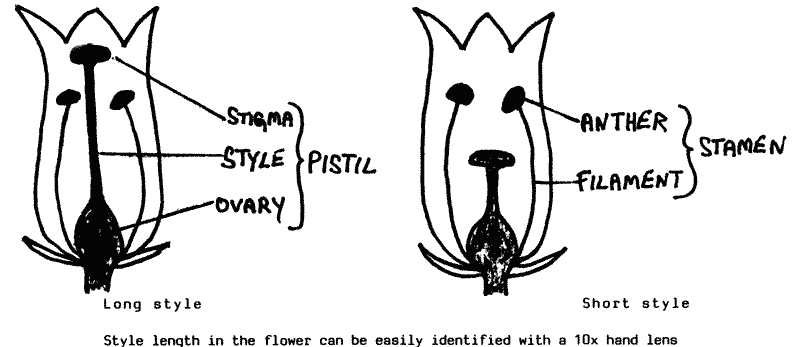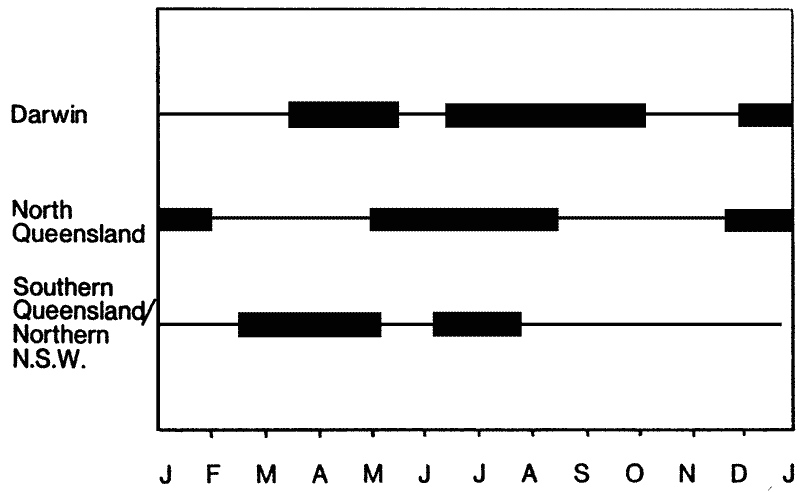
FRUIT SET IN CARAMBOLA
SCIENTIFIC NAME: Averrhoa carambola
FAMILY: Oxalidaceae
(A note from the Editor, David Hodge)
Further to a short article that appeared in the Port Curtis Branch February 1992 Newsletter, as quoted from an Ingham Branch Newsletter of August 1988. This mentions the problems of pollination and fruit set in Carambola. The flowers are heterostylous, meaning the varieties have styles of different lengths e.g.:

Style length in the flower can be easily identified with a 10x hand lens The following extract from "Carambola: a star on the horizon" by B.J. Watson, A.P. George, R.J. Nissen and B.I. Brown in the January-February 1988 Queensland Agricultural Journal explains the significance of style length.
FLOWERING AND FRUIT DEVELOPMENT
The carambola flower has usually five stamens, partially united at the base and a five-lobed compound pistil. The style, which supports the stigmas, is in two forms, short and long. Pollination studies in Florida indicate that short-style (the stigmas located below the stamens) cultivars are generally self-incompatible and require pollination from long-style (stigmas above the stamens) types. Long-style types are self-fertile.
The implications are not to plant short-style cultivars on their own.
However, singly planted short-style cultivars have been known to bear heavily in Queensland. Fruit are sometimes distorted in Fwang Tung cultivar. This may be due to incomplete pollination or the effect of temperature on pollen tube development. Style characteristics for some cultivars grown in Queensland are presented in Table 1.
Generally only 0.5% of the total flowers on one carambola tree must be pollinated to produce a satisfactory crop. Unlike many fruits, achieving high yields is not a problem with carambola, and in fact, overbearing is common and can lead to limb breakage. Sweetness and fruit size may be increased by thinning when fruit reach 20 to 50 mm in length.
The period from anthesis to fruit maturity varies according to temperature.
In southern Queensland, there are two major flowering periods, December-February and April-May. With the summer flowering, fruit development takes 10 to 12 weeks from anthesis, while with autumn flowering, it may take 12 to 16 weeks. The highest yields and best quality fruit are produced from flowers set in the first flowering period. Fruit maturing in late winter are generally small and not as sweet.
In north Queensland, major flowerings occur in September-November and February-April, although the peaks may vary by up to 5 weeks from year to year. The period from anthesis to maturity is about 12 weeks for both crops. However, individual trees may flower over a long period, (up to 2 months in late summer) and consequently, harvest may also be prolonged. The cycles tend to be 3 to 4 months cropping and 2 to 4 months resting. The most notable production gap is September to December (Figure 1). In comparison, Darwin in the Northern Territory has major flowerings in January-february, April July and a smaller one in September-October. Peak production is in April-May and July-October, with a smaller peak in December-January (Figure 1).
Australia-wide, the main production gaps are February-March and October-November. It is not yet determined if trees can be manipulated to produce in these periods. Some cultivars do have a wider spread of cropping (for example, B4, B10, Hart and Maha) but none produces over 12 months.
Table 1. Style characteristics of some carambola cultivars grown in Queensland
| Short-style | Long-style |
| B2 | B1 |
| B8 | B6 |
| B10 | B11 |
| Fwang Tung | B16 |
| Lu Tho | Star King |
| Wheeler | Maha |
| Kembangan | Arkin |
| Pat Chun | 11-1 (Kary) |
| 9-4 | |
| 8-1 (Kara) | |
Figure 1. The peak production periods of carambola for different regions of Australia.

DATE: March 19926
* * * * * * * * * * * * *
